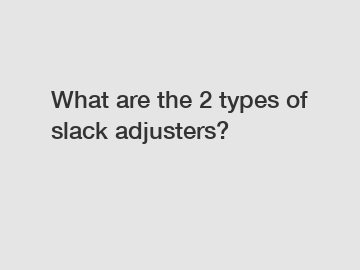What are the 2 types of slack adjusters?
What are the two types of slack adjusters? In the context of vehicle braking systems, slack adjusters play a crucial role in maintaining optimal braking performance. There are primarily two types of slack adjusters, namely manual slack adjusters and automatic slack adjusters. In this article, we will delve into the origins of these types, explore the process of their validation, and discuss their significance and impact in ensuring safe and efficient braking operations.
Types of Slack Adjusters:
1. Manual Slack Adjuster:

Manual slack adjusters were the traditional choice for adjusting the brake shoe-to-drum clearance in vehicles. This type requires manual intervention from the driver or mechanic to manipulate the brake adjustment mechanism physically. By rotating the adjusting bolt, the slack is taken up, ensuring proper braking responsiveness and reducing brake lining wear. These manual adjusters are commonly found in older heavy-duty vehicles and require regular inspections and adjustments to maintain brake performance and safety.
2. Automatic Slack Adjuster:
Unlike manual slack adjusters, automatic slack adjusters have become the industry standard in modern vehicles. These adjusters are designed to self-adjust the brake shoe-to-drum clearance based on the wear of the brake lining automatically. They utilize a self-adjusting mechanism that senses and compensates for brake lining wear, eliminating the need for manual intervention. Automatic slack adjusters constantly maintain the desired amount of slack between the brake linings and drum, improving braking efficiency, reducing downtime, and promoting safer vehicle operation.
Validation Process:
Significance and Impact:
The application of automatic slack adjusters has revolutionized the braking systems in vehicles by enhancing safety and reducing maintenance requirements. With manual adjusters, the risk of human error in brake adjustment is significant, potentially leading to inadequate braking performance, increased stopping distances, and uneven brake lining wear. Automatic slack adjusters eliminate these risks by constantly monitoring and adjusting the slack based on the actual wear of the brake lining. This feature ensures consistent brake responsiveness and maximizes the lifespan of brake components, ultimately promoting safer driving conditions.
Conclusion:
In conclusion, two types of slack adjusters are commonly used in vehicle braking systems: manual and automatic slack adjusters. The evolution from manual to automatic adjusters has significantly improved the reliability, safety, and efficiency of vehicle braking. Automatic slack adjusters, through rigorous validation processes, have become the preferred choice due to their ability to self-adjust and provide consistent braking performance. Understanding the differences between these two types is essential for vehicle owners, operators, and maintenance personnel to ensure optimal braking performance and safe driving experiences.
If you want to learn more, please visit our website benefits of air suspension, german type axle manufacturer, signs of a broken axle.

Comments